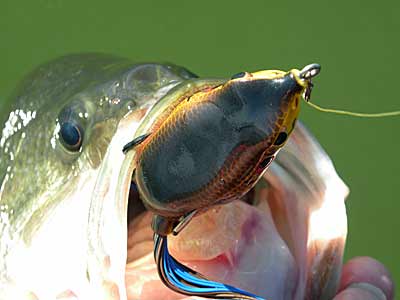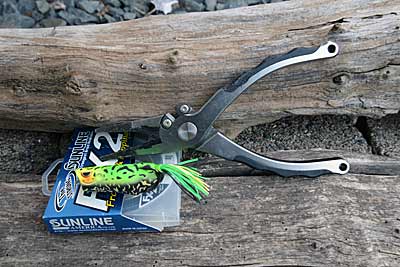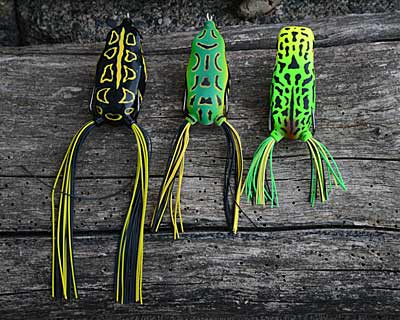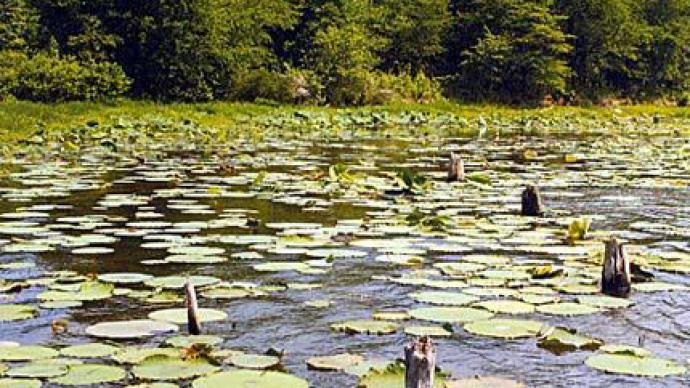
When we get to the summer months, there is one anticipated bite from the East to West coast that bass fishermen look forward to happening: the frog bite. Picture this. You get on the water, and you're driving to your favorite pad field with thoughts of the pads exploding as your frog passes overhead. This is what frog fishing is all about. When will the biggest bass in the area break through the pads and eat my frog? It is a bite that all bass fishermen live for.
Let’s take a closer look at a few tweaks that you can do to make your frog stand out and get more bites along the way to help you put a few more bass in your boat this summer.
Pay Attention To Your Hooks
When you take your frog out of the package, take a closer look at your frog. Yes, it's fishable when it comes out of the package, but there are a few things that you can do to get your frog ready to catch more bass.
The first is to adjust your hooks a little. Every frog manufacturer has their hooks set to be as weedless as possible and still catch bass, that is, if the bass bites down on the frog and compresses it. Now - be VERY CAREFUL - try this simple experiment. The easiest way to tell is to take your finger and run it across the hook points. Do the hooks grab your fingers as they go over the top of them? Chances are you will pass over the top of the hooks and not get stuck by the hook. Most frogs are made to fish clean as they come through the cover. My guess is you will have a 50% chance of hooking a striking bass.

To up these odds, take a pair of pliers and slightly open your hooks to sit a little above the body of your frog. This will create an angle that gets your hook points above the frog's body, significantly increasing your hook-up percentage.
Another point is to pay attention to how sharp your hooks are. As you catch more bass, you will start to dull your hooks. Every time you set the hook, you're potentially dulling the hooks each time you drive the hook into the fish’s mouth. In the mouth area of bass, there are bones throughout. So make sure that you pay attention to just how sharp your hooks are and make sure that the tips of your hooks are straight and not starting to bend over. To get a good solid hook into any bass in this situation, you need to have sharp, sticky hooks to put more odds in your favor.
Adjust Your Legs
One of the most customizable items on your frog is the rubber legs that your frog comes equipped with. I always have two frog rods on the deck of my boat, one with the legs of the frog untouched (long) and another rod that has a frog that I have trimmed the legs (short). These two frogs will have different actions when fished.

If you leave the legs long, that will limit how much movement that your frog will have side to side, and it will also limit how far your frog will move forward as the longer legs will create drag on the water, and this will limit how your frog will move forward with each twitch.
If you trim your legs, that will give your frog more movement. You will walk your frog, and it will also move with every twitch. Now you can look at this in two ways. Walking the dog with your frog will give it more of a side-to-side movement, but it will move far. But if you adjust the strength of your twitches, you can almost make it dance in place and hardly move far at all.
These tactics allow you to adjust how you fish your frog according to the bite conditions you face that day. For example, if the bass aren't moving far from the cover, I'll grab a frog with short legs to work this frog more in place to trigger bites. I can make my frog dance closer to the cover as it won't move that far from the cover.
I'll start fishing with a frog with longer legs when the bite is off. The longer legs will create more drag and slow the frog's action down, attracting more bites from the less active bass in the process. If I get into an area that I'm sure is holding bass and can't get the bass to trigger with one frog, I'll give the other frog a few casts before moving on. Sometimes just a different action will trigger bites.
Another tactic that I'll also use is if you get a bass to blow up on your frog and it misses, grab the other frog to show them something different. This will sometimes trigger a strike from a bass that won't come back and hit the original frog again. Showing them something different can get a strike when the same frog won't.
Add Weight To Your Frog
An old river fisherman’s trick is to add weight to your frog. The best way to do this is to get a package of BBs. Put about 10 BBs into your frog to start in the hole around the hook. You may have to use a small tube of silicone to close the hole back up a little to keep the water out.
When fishing in and around duckweed, use these specially rigged frogs. There are three benefits that you will get out of these doctored frogs. One is greater casting distance; many times, you're limited to areas that you can reach on the river, and how many times have you wished that if you could get an extra 10ft to 20ft added to your cast, you could reach that special place that you think is holding the biggest bass of the day. You can often reach these areas with your doctored frog with the added weight.
The next advantage of weighting your frog, it will sit lower in the water; this is vital when fishing in duckweed. Your frog will sit on top of the duckweed, and the bass won't be able to see your frog, which will mean fewer strikes. By adding weight, your frog will sit lower in the water to where the bass can focus on it before they strike. This will result in more strikes, and a better hook-up ratio as the bass will be dialed in on the frog when it strikes.
Also, add the sound factor that the BBs add, helping the bass find your bait when it doesn't get a good look at your frog. I have seen bass wake the bait before it hits it. I feel a lot of this is because of the sound added to the frog with the BBs.
I hope that you add these frog tweaks to your tactics this year. There is no better bass bite than to see your frog disappear as it comes off a pad. The more you make your frog stand out, the more bites you will get by the end of your day on the water.




